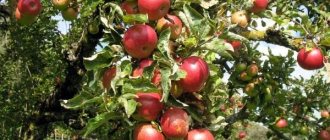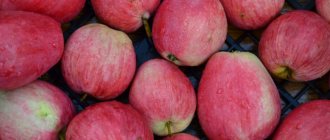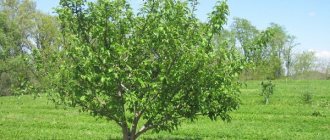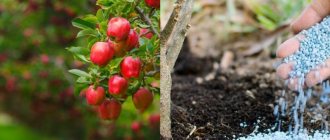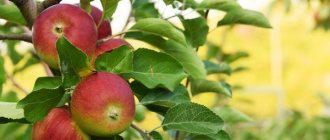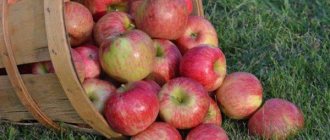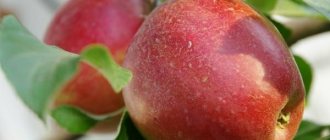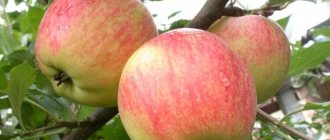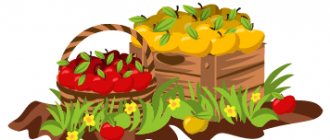Summer apples are one of the favorites of many. They ripen in July and begin the apple season. These varieties of apples have many advantages, thanks to which they grow in personal plots and delight owners with their fruits. Papirovka is an apple tree known to many; it is called White filling for the color of the fruit. This very common apple variety is worthy of the attention of gardeners for its qualities.
Apple variety Papirovka.
Description of the variety
Papirovka apple trees are included in the State Register of Russia and have become widespread throughout almost its entire territory for their frost resistance and early ripening of fruits.
A medium-sized tree with a broad-pyromidal crown, which becomes round over time, fruit branches of medium thickness, greenish-brown, leaves of gray-green color, medium size, heavily pubescent. The flowers are large, the buds are pink, the blooming flowers are white, with pink edges. The fruits are medium-sized, round-conical, with clearly visible ribs and a thin seam running along the peel. The color of the fruit is greenish-yellow, the skin is covered with a whitish coating and barely noticeable white and gray dots, and when ripe it becomes pale white. The pulp is white, loose, sweet and sour, with hints of acid.
You can see what a Papirovka apple looks like in the photo.
Variety Paping.
Selection
Apple Papirovka comes from the Baltic countries. But very quickly it spread throughout Russia, Ukraine, Belarus and Europe.
Commercial and consumer qualities of fruits
The size of the fruits depends on the age of the trees (they are larger on young ones), soil and climatic conditions and weather factors. On average, apples weigh 80-100 g , but can gain up to 150-200 g. They are uneven in shape - often round-conical, slightly flattened, with wide, clearly visible ribs; large specimens are sometimes triangular. The fruits often have a characteristic sharp seam (a longitudinal fold of the skin).
A distinctive varietal feature is the presence of a sharp longitudinal seam on the apples.
The skin is smooth and dry, thin and tender, covered with a light whitish coating at the time of removable ripeness. The color is solid, without an integumentary blush, greenish-yellow in color, which in the process of ripening becomes lighter, straw-colored. Subcutaneous dots are large, numerous, grayish-white or greenish. A slight rustiness sometimes appears in the funnel area.
The pulp is white, tender, coarse-grained, loose, quite juicy, with a faint aroma. When overripe on the tree and during storage for more than 2-3 weeks, it becomes mealy, “potato-like.” The taste of apples is sweet and sour, with a clear excess of acid. Various sources indicate its tasting scores as 3.5-3.9 or 4.0-4.2 points (out of 5).
According to research conducted by VNIISPK specialists, the biochemical composition of the fruit contains:
| Nutrients and beneficial substances | Quantity per 100 g of product |
| Vitamin C (ascorbic acid) | 21.8 mg |
| Sahara | 9.0 g |
| Acids | 0.97 g |
| P-active substances (total) | 209 mg |
| Pectins | 10.0 g |
Apples of this variety are distinguished by a high content of vitamin C and catechins, which makes them a valuable raw material for industrial and home production of juices. The fruits are also used for other types of processing: making preserves, jams, jams, compotes.
Collection and transportation
Apples reach ripeness early: they begin to harvest in late July – early August. At the time of picking, the fruits are ready to eat; their taste and aroma are revealed immediately.
If harvested untimely, overripe apples with thin stalks are prone to shedding
Due to the fact that the pulp is loose and the skin is very thin and has no outer color, careless handling of the fruit, any blows or pressure leads to the appearance of quickly darkening spots. The harvested crop does not tolerate transportation well and is not intended for long-term storage. The consumer period is no more than 1 month.
Characteristics
The Papirovka variety has a number of advantages that are highly valued in summer ripening apple trees.
Tree height
Papirovka is a medium-sized tree, up to 5-6 meters high; plants grown on strong black soils reach 9 meters. In the first years after planting, the tree grows actively, and then the annual growth decreases.
Crown width
The tree lends itself well to crown formation; the maximum crown size with a diameter of 5 meters was observed.
Productivity
The apple tree produces a full harvest starting from 9-10 years after planting. Up to 80 kg are harvested from one tree, the maximum yield is 200 kg.
Tasting assessment
Papirovka apples have a sweet and sour taste characteristic of this variety, with a slight sourness, tender, juicy. In overripe apples, the pulp becomes loose and mealy.
Tasting score 7.9 points out of 10.
Winter hardiness
Apple trees of the Papirovka variety are distinguished by high winter hardiness; young trees in regions with cold winters are advised to be insulated.
Apple tree in winter.
Self-fertility
To pollinate Papirovka, you need varieties that bloom at the same time as it, and favorable weather conditions so that pollinating insects can transfer the pollen.
Pollinator varieties
The best pollinators for the Papirovka apple tree will be Anis Striped, Grushevka Moskovskaya, Suislepskoye. For some of them, this apple tree can be a pollinator.
Disease resistance
Gardeners note the apple tree's good resistance to diseases. But there is no need to neglect preventive treatments to avoid infection of trees, especially at high humidity.
Resistance to scab is average; at the first signs of damage to the tree, it is immediately treated with appropriate preparations.
History of selection
Early information about apple trees of the Papirovka variety dates back to the beginning of the 19th century. At first, the variety was cultivated exclusively in its homeland - in the Baltic states . But very soon it became widespread in Germany and Poland.
The first apple trees of the Papirovka variety appeared in western Ukraine and Russia. It is not for nothing that the name of the variety shows Ukrainian and Polish roots (translated from Polish and Ukrainian, the word papirovka is translated as paper or paper). There is every reason for this. As apples ripen, they turn from pale green to creamy white like a sheet of writing paper.
Today Papirovka represents a variety type that unites several related varieties of apple trees. On its basis, a number of apple crops have been developed that have excellent consumer qualities.
Photo of apple tree variety Papirovka:
Ripening and fruiting
The timing of flowering and fruit ripening differs, depending on the region where the variety is grown.
Bloom
The apple tree begins to bloom at the end of April in the southern regions, in the northern regions it lasts until the second ten days of May. It is important to feed the apple tree during flowering.
Apple tree blossom.
Ripening time
Apples ripen at the end of July and are one of the first to open the season, but in the northern regions they ripen by mid-August.
Features of fruiting and reasons for its absence
Papirovka begins to bear fruit 3-4 years after planting; if it is grown on a seed rootstock, it begins to bear fruit later.
Lack of harvest occurs for several reasons: if the apple tree does not have enough moisture or it receives inadequate fertilizing.
Possible overload of fruits, the apple tree has put in a lot of effort and is resting for the next year.
Eliminating known causes will help to obtain an annual harvest.
Shelf life of fruits
Papirovka or White filling sticks well to the branches when ripe and does not fall off. When the period of harvest ripeness arrives, this makes it possible to pick apples without damaging them. They can be stored in the refrigerator for up to a month.
The variety is suitable for making juices, preserves and jams.
Pollination
Apple trees of the Papirovka variety are self-sterile. For good fruiting, they need pollinating apple trees growing in the neighborhood. Necessary condition: trees must have a similar flowering period and have a sufficient amount of pollen in the anthers. And if there are bee hives nearby, pollination will be even more active.
For Papirovka, the best pollinators are the following varieties:
- Anise Striped;
- Grushovka Moskovskaya;
- Chinese Bellefleur;
- Robin.
Papirovka, in turn, is a good pollinator for the Grushovka and Malinovka apple trees.
Planting and care
Compliance with the basic rules of planting and care gives positive results. The planted tree grows and develops well and produces a good harvest.
Seedlings for planting.
Landing dates
The seedlings are planted in the spring, before the buds open. Usually this is the beginning of April. In autumn - after leaf fall, but a month before the onset of frost, in mid-October. Planting dates are adjusted according to the planting region.
One- or two-year-old seedlings take root well; seedlings older than two years are transplanted if there is a large lump of earth on the roots.
When can you replant and is it necessary?
There is an opinion that if a seedling is transplanted several times from place to place, this will improve the quality of the fruit. Experienced gardeners say that this is harmful to the tree and it is better not to do it.
Pruning and crown formation
The crown of the tree is formed starting from the second year after planting, when it is actively growing. An adult tree needs to be cleared of dry, cracked and broken branches. This pruning is usually done in the spring.
Apple tree pruning diagram.
Top dressing
Fertilizing for an apple tree is important. They start feeding the tree in the first year and do it annually.
In the spring, at the beginning of flowering, the next time they feed is when the fruits are full, and always after the leaves fall.
Graft
Apple tree Papirovka can be either a rootstock or a scion. The main rule of grafting is that only appropriate varieties can be grafted onto a summer-ripening variety.
How to vaccinate, watch the video.
Permissible groundwater level
For normal tree development, the water level to the surface should be no higher than 3 meters. Otherwise, the roots may rot and it will die.
Reviews from gardeners
Matvey, 54 years old, Kiev region
The variety is very good, well known to everyone, it has been growing in my dacha for a long time. It bears fruit consistently and produces large yields. The fruits are tasty, but when you pick them you need to be careful, otherwise all the dents immediately darken and the apples do not last long. Compotes made from them are very aromatic and tasty.
Igor, 48 years old, Saratov region
As for me, Papirovka (White filling) is worthy only because it ripens very early (ours is the earliest). The pulp is loose, too sour; when overripe, quite often the thin skin of the apples bursts, and the pulp becomes dry and generally tasteless. The tree is not resistant to sunburn in early spring (early March); as a result, it is subsequently affected by cancer. But despite all the shortcomings, the apple is traditionally in demand on the market because it appears first.
Anatoly, 43 years old, Syzran
Padding is not suitable for our area. The taste of apples is fresh and sour, even wild ones are tastier, especially Candy. In terms of yield, it also cannot be compared with the same Moscow Grushovka, for example. In general, it is a useless variety, which is why it is now very rarely found even in nurseries.
Svetlana, 58 years old, Krivoy Rog
A very aromatic and tasty apple. Particularly suitable for adding to pear and apricot jam – it adds natural thickness and improves the overall aroma. And what a wonderful puree you get from apples! The grandchildren really like it! We eat part of the harvest immediately fresh, I cook summer compotes with berries. So this is our favorite apple tree in our garden.
Variants and subtypes
When choosing a seedling for planting, it is important to make sure that the seller is honest and check its varietal names.
Semi-dwarf
The variety Papirovka, grafted onto a semi-dwarf tree, is called a subspecies.
It has less resistance to frost than the Papirovka variety and requires regular pruning, otherwise the tree will crack due to grafting.
Amber
Obtained in private nurseries from crossing the mother variety and Yantar. It is not listed in the State Register.
Baltic
This subspecies of apple tree does not exist. For variety, traders came up with a new subspecies of the usual Papirovka, as if bred in the Baltic states.
Ural
The name Papirovka Uralskaya does not correspond to the existing daughter Papirovka. This variety is called Ural Bulk, obtained by crossing the Ranetka Krasnaya and Papirovka varieties.
Summer
The Papirovka apple tree is a summer variety, and a plant named this way is not worth buying, because it is identical.
Altai
Altai ruddy is a less popular variety than Papirovka. That's why they sell one variety instead of another.
Red
In dubious places of sale, inexperienced gardeners are offered Ural liquid for red Papirovka. This subspecies of the Papirovka apple tree does not exist.
Honey
The apple tree variety Medunitsa is sold for White honey filling. And although this is not a completely original variety, the apples are delicious.
Winter-hardy
Papirovka is a winter-hardy variety, and you shouldn’t chase any new products.
Features of growing varieties in different regions
Appropriate recommendations help to grow Papirovka in different regions.
Growing apple trees in the Urals.
Ural
Mandatory whitewashing of trunks protects trees from burns in February.
In autumn, young trunks are damaged by mice and therefore need protection.
Belarus
Timely treatment of Papirovka against scab and other fungal diseases will help to achieve good harvests.
Feeding trees with fertilizers containing microelements that are lacking in Belarusian soils.
Where can it be grown?
The advantages of the Papirovka variety were appreciated back in the Soviet Union. It was consistently included in the State Register of Breeding Achievements of the Ukrainian Belarusian and Russian Socialist Republics:
- In 1947 – to the State Register of the RSFSR.
- In 1950 - to the State Register of the Ukrainian SSR.
- In 1954 to the State Register of the BSSR.
Today Papirovka is called one of the main early summer varieties and is actively used in breeding work.
A reliable frost-resistant variety of apple trees is grown throughout Russia, including areas of risky farming. Provided the trees are well protected from frost, it takes root well and bears fruit even in the Urals and Siberia. Features of growing Papirovka in distant regions are as follows:
- When grown in the Urals, trees are whitened for the winter, protecting them from sunburn. In addition, the trunks of young apple trees are protected from rodents.
- When grown in Belarus, care is taken to ensure that apple trees are protected from scab and powdery mildew. Since the soil in these areas is poor in magnesium, manganese and molybdenum, trees are regularly fertilized with preparations based on these microelements.
Expert opinion
Chernyaeva Tatyana Dmitrievna
Absolutely loves gardening and grows only organic vegetables
Ask a Question
Due to its low shelf life, Papirovka is planted mainly in small private gardens. Gardeners in Papirovka are especially attracted by the excellent yield (up to 180 kg of apples are harvested from one tree per season).
Apple tree care
The Papirovka variety is considered easy to care for, but the basic rules of agricultural technology must be followed. This apple tree finds it difficult to adapt to new climatic conditions and takes a long time to adapt. In arid regions, more attention will need to be paid to watering; in areas of harsh climates, fertilizing with organic matter will be necessary.
Watering
The usual volume of water for a fruit tree is 20-30 liters (once a week), if there is no precipitation. In summer, water regularly, monitoring the condition of the soil near the apple tree. Lack of moisture affects the yield of the variety.
Fertilizing
In the spring, as soon as the sap begins to move along the branches, fertilizers are applied. On poor sandy soils, increase the dose of nitrogen; on fertile soils it can be omitted. Complex fertilizers (nitroammophoska - 40 grams), urea (0.4-0.5 kg) are suitable.
During the flowering period of Papirovka, diluted mullein or bird droppings and diluted superphosphate (50 grams per 10 liters) are used as fertilizing. Liquid fertilizing is effective in the absence of rain, but if there is enough rainfall in the spring, urea (0.5 kg) or humus is scattered in the tree trunk circle.
In the autumn, potassium and phosphorus are added, excluding nitrogen. On fertile soils, it is not possible to feed an apple tree every season (once every two years).
Papirovka may not bear fruit every year, for various reasons:
- imbalance of batteries;
- lack of food;
- lack of microelements (manganese, sulfur, magnesium).
Apple tree pruning
It is carried out in the spring, when thickened shoots, diseased, excess and deformed branches are removed. When forming the crown of a tree, you cannot remove a large number of branches at once; this should be done gradually.
Papirovka’s crown is also thinned out annually, which increases yields and protects the apple tree from infections and possible pests.
Description and characteristics of the White filling apple tree
The variety is unique for its long lifespan. There are specimens that, having lived up to 70 years, continue to bear fruit. True, with age the fruits become somewhat smaller. The variety is easy to recognize by its characteristic external features.
White filling is a summer early ripening variety. Ripens differently in different climate zones:
- in the south - mid-July;
- middle zone - mid-August;
- Siberia – second half of August.
Tree
The White filling apple tree is a classically beautiful medium-sized tree. It reaches a height of 5 m. Features of the tree:
- Bark. Color – light grey. Young apple trees have smooth bark. Over time it becomes rough.
- Crown. While the tree is young, its crown is elongated - pyramidal in shape. An adult tree acquires a rounded, moderately spreading crown.
- Leaves. The shape is ovoid. Color – green, size – medium, slightly pubescent on the inside. They differ from other varieties by having longer petioles (that is why they are called Long-stemmed).
- Flowers. Large, white, saucer-shaped. There is often a pinkish “patina” on the petals. Flowers are in large inflorescences.
Fruit
Fruit formation is on white-green ringlets. Description of fruits:
- Form. The apples are large, round-conical, tapering towards the cup.
- Weight. Fruits on young apple trees grow up to 150 g, on old ones - up to 60 g.
- Pulp. White, juicy, sweet taste, with slight sourness and a subtle apple aroma.
- Color. Green apples turn white when ripe. Apples hanging on the south side of the tree become covered with a delicate light pink blush when ripe. On one side of the fruit there is a seam running from the tail to the cup.
- Skin. Thin, compared to the pulp - sour.
- Taste. Changes as it matures. Unripe fruits are sweet and sour. As apples ripen, they become sweeter, the sugar content increases, and the fruit acquires a dessert taste with a barely noticeable sourness. The fruits generously filled with juice are especially tasty. Tasting score – 4.7.
White filling apples are delicious fresh and are a valuable raw material for processing. They are used to make jam, marmalade, juices and wines. The fruits are quite sweet - they contain 9% sugar.
You can see an overview of the White Filling variety in the video below:
Root system
The type of root system is determined by the characteristics of the rootstock:
- vigorous-growing ones have a powerful central rod;
- low-growing (dwarf and semi-dwarf rootstocks) - a highly branched root system that does not have a central core.
Productivity
White filling is a productive variety. With good care, the tree is simply covered with fruits. The average yield is 80 kg per tree. If the tree is provided with ideal conditions, it can produce up to 200 kg of apples.
The first apples are harvested in the fifth year of planting a two-year-old seedling. Fruiting as the tree matures acquires a certain periodicity.
Self-fertility and pollinating varieties
The variety is self-sterile - it needs pollinators. For pollination of White filling, it is recommended to use:
- "Antonovka";
- "Ottawa";
- "Lungwort";
- “Moscow Grushovka”;
- "Candy";
- “Golden Chinese woman”;
- "Cypress";
- “Early pear”;
- "Mantet."
If a pollinating variety is not planted nearby, there will be few ovaries on the tree, and their size will be smaller than normal. As pollinators, mainly varieties are selected whose flowering coincides with the flowering of White Fill.
Winter hardiness
The variety is winter-hardy, able to withstand harsh winters, preserving the ovaries. It also survives spring frosts well for the future harvest. The winter hardiness of the variety is not enough for growing in the northern regions - growing White filling here is not practical.
Disease resistance
The variety does not have high immunity. White filling is affected by a number of diseases and pests, and therefore requires preventive treatment. Thus, White filling does not have immunity from one of the most serious diseases of fruit trees - scab. This scourge especially actively affects thickened and unthinned trees. Wet weather also contributes to scab.
Advantages and disadvantages
Among the advantages of the variety are noted:
- earlier ripening of the crop,
- early onset of fruiting period,
- easy care,
- high taste qualities of fruits,
- good winter hardiness,
- high yields.
Main disadvantages:
- low shelf life of the crop, which determines the need for its processing in the shortest possible time;
- poor transportability of apples makes the variety unsuitable for use in intensive gardening.
Diseases and pests
Apple trees of the Papirovka variety are not particularly resistant to common diseases characteristic of this crop. In normal times, the risk of diseases is low, but during periods of epiphytoty (spread of infectious plant diseases), diseases are recorded quite often (especially in weakened trees):
- Scab is a common fungal disease of apple trees, which affects the fruits, leaves, petioles and inflorescences. The fungus Venturia inaegualis settles in wood tissue. During the period of bud formation, volatile spores fall with the air current onto neighboring trees. The parasite is especially active during the wet season. Treatment usually begins in early spring. The following drugs are used: Bordeaux mixture, Horus, Speed. An effective prevention of scab is sanitary pruning.
- Powdery mildew primarily affects young shoots. The main symptom of the disease is a whitish coating. The mycelium of the microscopic fungus Peronosporaceae penetrates the above-ground tissues of the tree, disrupts vital functions, and actively spreads to other trees. The affected parts are cut off and the soil around the tree trunk is dug up. Therapeutic measures - treatment with soda solution, manganese solution, infusion of onion peels or garlic.
- Among insect pests, the most dangerous for Papirovka is the codling moth , which can completely destroy the crop. The caterpillar penetrates the pulp of the fruit, where all its stages of development take place. At the initial stage of the disease, the affected shoots and fruits are removed. Caterpillars are collected manually or caught with special trapping belts applied before the butterfly begins to fly out of the cocoon.
Planting an apple tree
Nedzvetsky apple tree - history, description and characteristics of the variety
The apple tree of this variety is sensitive to growing conditions. Therefore, you should choose a place for it very carefully. It is best to find an open sunny area for the tree, which is as close as possible to the rest of the apple trees. Trees should be located at a distance of 4-5 m from each other.
1 week before planting, it is necessary to dig a hole. Its depth should be 90 cm. Fertilizer should be placed at the bottom. It should include 1 kg of mineral preparation, 800 g of wood ash and a bucket of humus.
After this, you need to pour soil from the top layer onto the bottom. Before planting, the soil in the hole needs to be loosened a little and water added. These manipulations should be performed between the end of March and mid-April.
Planting an apple tree has certain features
